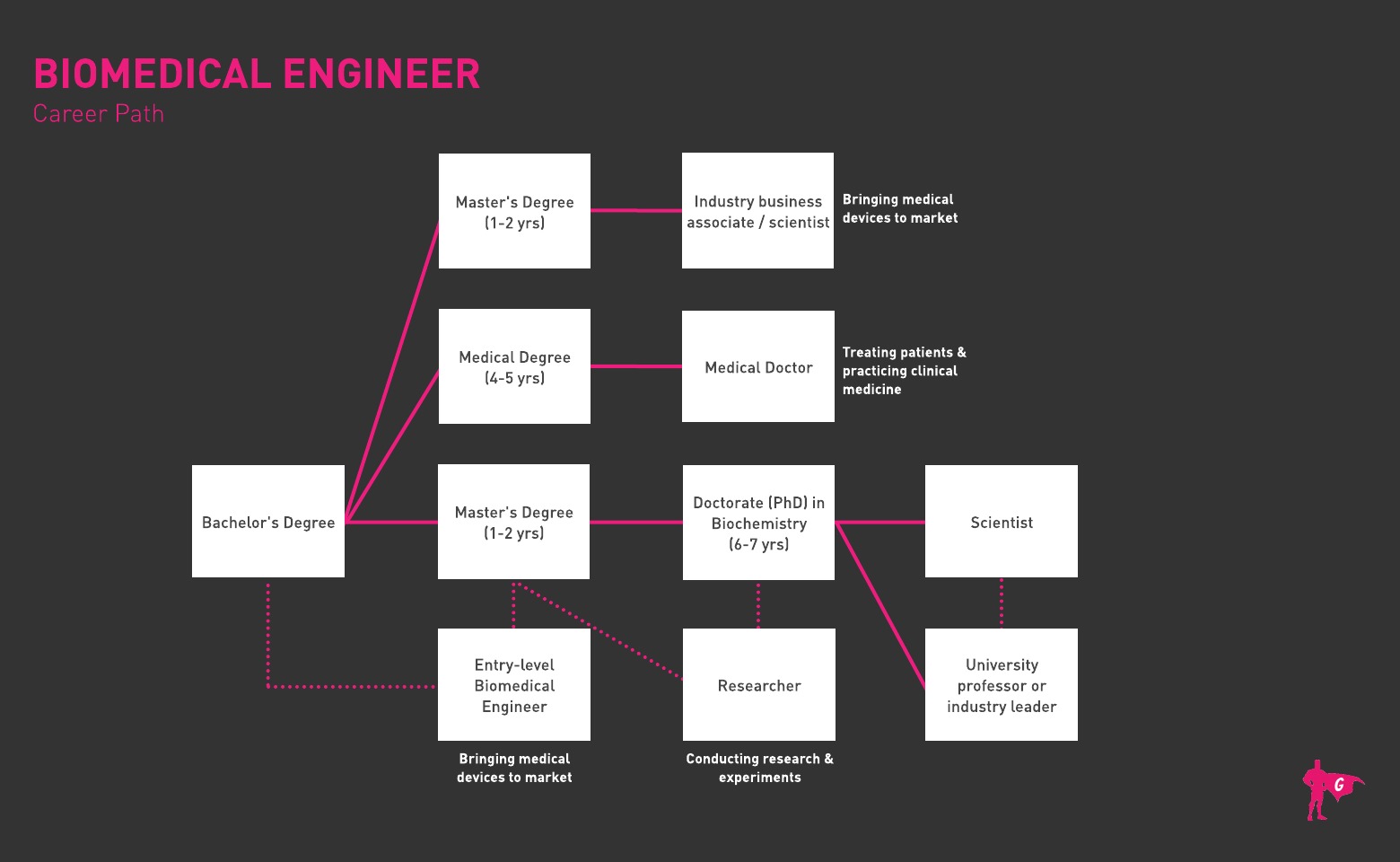Spotlights
Biomedical Electronics Technician, Biomedical Engineer, Biomedical Engineering Technician, Biomedical Equipment Technician (BMET), Biomedical Technician, Engineer, Process Engineer, Research Engineer, Research Scientist
Biomedical Engineers work in a broad field that currently has a relatively small number of workers. Collaborating with scientists and chemists, they help make cutting-edge medical IT, devices, and equipment used in modern hospitals and clinics around the world. They also work on life-saving artificial organs and replacements for other parts of the human body such as knee joints.
There are different areas of specialization, including Bioinstrumentation, Biomaterials, Biomechanics, Clinical engineering, Rehabilitation engineering, and Systems physiology. As you can see, there is plenty of opportunity for diversity in this sector. However, they all share a common purpose of creating technology to assist people.
As with any mechanical or electrical device, there will always be requirements for maintenance, diagnostics, repairs, and tech support. Biomedical Engineers help to ensure the items they create function properly and safely. There’s a considerable amount of research and design involved, as well as tons of technical writing and presentation preparation. Once created, products must be marketed and sold to buyers, so there are teams who focus on this aspect of the field, too.
- Having a direct impact on patients’ life spans and overall quality of life
- Continually contributing to the advancement of medical technologies
- Gaining experience with the business side of the healthcare profession
- Potentially inventing items for patenting
Lịch làm việc
- Biomedical Engineers work full time, with occasional overtime required in some cases. For instance, when there is a high demand or urgent need for the production of a certain product, schedules may require working extra hours to meet deadlines. Also, employees must ensure they’re always current with changes affecting their field. This can require significant reading and research outside of “office hours.”
Nhiệm vụ tiêu biểu
- Designing hardware and software for various medical uses
- Conducting detailed research related to biology and chemical processes
- Working with or managing teams and other engineers
- Assessing the designs of biomedical components to be used inside patients
- Conducting operational testing and analyzing findings
- Complex technical writing and diligent records keeping
- Performing sensitive calibrations using technical equipment
- Training peers or subordinates on processes
- Trách nhiệm bổ sung
- Assisting buyers and providing training on the proper use of products
- Developing alternative energy solutions
- Quản lý hàng tồn kho
Kỹ năng mềm
- Nói rõ ràng
- Strong technical writing skills
- Có khả năng tư vấn và hướng dẫn người khác thông qua hướng dẫn bằng lời nói và bằng văn bản
- Analytical problem solving
- Phương pháp
- Mục tiêu
- Patience and persistence
- Focused on quality assurance
- Goal-orientation; ready to tackle challenges
- Planning and organizational skills
- Kỹ năng nghiên cứu và xử lý sự cố
- Định hướng nhóm
- Empathy dealing with patients
Kỹ năng kỹ thuật
- Creative, especially in design areas
- Ability to read and comprehend complex technical texts
- Deep understanding of biology and applicable engineering and technology
- Knowledge of software applications, in particular those related do:
- Medical, analytical, and scientific
- Thiết kế hỗ trợ máy tính
- Môi trường phát triển
- Object/component oriented development
- Strong math skills, including calculus and statistics
- Ability to create compelling presentations and reports
- Focus on practical, real-world solutions versus theory
- Companies making medical equipment, medical supplies, or auxiliary items
- Các ngành chăm sóc sức khỏe
- Pharmaceuticals
- Higher education institutes
- Research and development groups
- Military/governmental agencies and contractors
- Social welfare organizations
Biomedical Engineers bear the weight of enormous responsibility. Unlike physicians who may see specific patients on occasion, Biomedical Engineers create devices implanted permanently inside patients! The effectiveness and proper functioning of such devices can impact the quality of life of those individuals. Meanwhile, malfunctions or other unexpected problems can have serious, even life-threatening consequences.
Workers in this field must go to great lengths to ensure their research is accurate, and that they’ve developed solutions that will work as designed. They have to anticipate issues and train buyers on use, maintenance, and what to do in case of trouble. An organization’s entire reputation is on the line when a product or service is released into the world, so when things go wrong, engineers get scrutinized. Thus they need to be patient, have a tough skin, and be ready to answer questions at any time.
Curiously, the Bureau of Labor Statistics only predicts a 4% job growth outlook for Biomedical Engineers over the coming decade. This is slightly below average. However, changes are certainly expected within the field itself, as technology continues to evolve at an increasing pace. As tech advances, opportunities open. For example, 3D printing is becoming an area of increased focus in the Biomed world. Meanwhile, smart technology continues to bind us to an ever-widening network of connected devices, so this is another area being explored.
A further consideration impacting the future outlook for Biomedical Engineers is the increasing life expectancy rate for citizens. As populations live longer, the need for products will continue to expand. However, advanced aging can affect the ability to perform certain surgeries to implant certain items. This may potentially drive research into new paths to seek non-surgical alternatives to existing products.
Biomedical Engineers were likely always curious about both biology and technology, and how the two can function together. They may have been fond of science fiction books and films featuring futuristic characters such as cyborgs and androids. Indeed the science fiction genre has long been at the forefront of predicting ways that humans will intersect with man-made devices such as computers or robotic equipment.
In their younger days, Biomedical Engineers may have also drawn inspiration from real-life pioneers in the field. They might even have had a family member who relied on a biomedical device for survival. In addition, there could also have been an interest in military and warfare topics. The military has long been a supporter of advanced technologies designed to enhance the performance of troops, as well as to empower survivors of serious wartime injuries. This is why many veterans consider civilian jobs in this critical field.
- Biomedical Engineers generally have at least a bachelor’s bioengineering or biomedical engineering
- Per O*Net Online, 53% of Biomedical Engineers have a bachelor’s, 30% have a master’s, and 7% have a PhD
- Common courses include chemistry, physics, biology, math (algebra, geometry, trigonometry, calculus), drafting, mechanical drawing, computer programming, bioengineering, biomedical engineering, fluid and solid mechanics, circuit design, and biomaterials
- Note, biomedical engineering college programs should be accredited by ABET
- In-person programs should include plenty of laboratory work. Lab experience can also be obtained via Biomedical Engineering internships
- Biomedical Engineers can become licensed Professional Engineers if they want to gain a valuable credential to help land better jobs
- Certain jobs may require additional certifications, such as ETA International’s Biomedical Electronics Technician cert
- Programs should be accredited by ABET (the Accreditation Board for Engineering and Technology)
- Review the program’s ties to industry, as well its job placement rates for graduates
- Check with the school’s career counseling services for ways it helps students find jobs
- Biomedical Engineering can involve hands-on work, making certain on-campus experiences beneficial. However, many students need a flexible online format. Consider your intended area of specialization when deciding on an on-campus or online program
- Prepare for college by taking science classes, including biology, chemistry, and physics
- Don’t forget to build a strong math foundation in algebra, geometry, trigonometry, and calculus
- Experience with drafting software, mechanical drawing, and programming will come in handy
- Study current topics, but build a rock-solid understanding of core concepts
- Seek out internships/co-ops that offer practical experiences
- Join relevant groups dedicated to the field; several universities host engineering clubs and organizations
- Devote time every day to polishing your technical reading and writing skills
- Remember that there is a sales and marketing element to some areas in this field, as well as a strong customer service component
- Practice your public speaking and presentation technique
- Volunteer at clinics or locations where patients may rely on biomedical technologies
- Stay ahead of the curve by reading industry materials and joining national and international professional organizations, such as:
- American Institute for Medical and Biological Engineering
- American Society of Biomechanics
- American Society for Engineering Education, Biomedical Engineering Division
- American Society of Mechanical Engineers, Bioengineering Division
- Hiệp hội vì sự tiến bộ của thiết bị y tế
- Biomedical Engineering Society
- European Society for Biomaterials
- European Society of Biomechanics
- IEEE Engineering in Medicine and Biology Society
- Institute of Biological Engineering
- Institute of Physics and Engineering in Medicine
- International Federation for Medical and Biological Engineering
- International Society of Biomechanics
- International Society for Prosthetics and Orthotics
- International Union for Physical and Engineering Sciences in Medicine
- PLoS Medicine
- Society for Biomaterials

- Roughly 11% of Biomedical Engineers work in the areas of pharmaceuticals and medicine manufacturing; 7% work at colleges or universities
- Các dự án BLS tăng cơ hội việc làm trong một số lĩnh vực nhất định như nghiên cứu y sinh, R&D công nghệ sinh học, năng lượng, sản xuất thực phẩm và bảo vệ môi trường
- To get a job as a Biomedical Engineer, you’ll need to have your undergraduate studies completed
- Though not required for most entry-level positions, a master’s can certainly put you ahead of the competition
- Try to complete an internship or work experience related to the field, in order to gain as much practical experience as possible
- List all of your work and academic experiences on your resume, focusing on those relevant to the position you’re applying for
- When possible, incorporate as much hard data as you can squeeze in, such as numbers, statistics, etc.
- Don’t forget to mention any volunteer or extracurricular activities that demonstrate skills applicable to the career field, even if they aren’t specific to the biomedical industry
- Make your application perfect and error-free, and ensure you respond to all required items listed on the job posting
- Consider investing in a professional resume writing service or at least an editor
- If you have not done a job interview in a while, practice by doing mock interviews
- Tailor your resume/cover letter to the organization you’re applying to. Demonstrate how your experiences and values align with their needs and goals
- Ask instructors who can speak about your applicable qualifications to write letters of recommendation or to serve as references
- Scour job boards such as Indeed, Monster, Glassdoor, LinkedIn, and any industry-specific or college-sponsored portals
- Ask your college what services they offer to help place you in a position
- Update your LinkedIn profile. Recruiters and hiring managers may take a peek at it, as well as your other online profiles...including social media!
- To get ahead or have increased responsibilities such as leading teams, you’ll likely need a graduate degree
- Your graduate area of study should be based on the specific job you want, so plan for the long-term. Some worker obtain an MBA, while others go to medical school
- Study the positions and duties of those you work for. Find a person who is doing what you’d like to do and ask them to mentor you
- Don’t be shy! Let your organization know you are focused on your current job, but interested in future career-broadening opportunities
- Excel at tasks you’re given; offer solutions when citing challenges and obstacles
- Pay your dues and put in the overtime when required
- Never cut corners but do look for ways to improve process efficiency and efficacy
- Join professional organizations (see our list above)
- Stay up on trends with an eye on pending breakthroughs and advanced technologies
- Be a professional trainer, relied on to teach others how to perform difficult tasks
- Comply with internal and external policies; maintain the utmost integrity on-and-off duty
Các trang web
- Hội đồng công nhận kỹ thuật và công nghệ
- Hiệp hội vì sự tiến bộ khoa học Hoa Kỳ
- American Board for Certification in Orthotics, Prosthetics and Pedorthics
- Hiệp hội Hóa học Hoa Kỳ
- American Institute for Medical and Biological Engineering
- Viện Kỹ sư Hóa học Hoa Kỳ
- Hiệp hội Giáo dục Kỹ thuật Hoa Kỳ
- American Society for Healthcare Engineering
- Hiệp hội Vi sinh vật học Hoa Kỳ
- Hiệp hội Kỹ sư Nông nghiệp và Sinh học Hoa Kỳ
- BioMed Central
Sách vở
- Biomedical Device Technology: Principles and Design, by Anthony Y. K. Chan
- Biomedical Engineering and Human Body Systems, by Rebecca Sjonger
- Introduction to Biomedical Engineering Technology, by Laurence J. Street
- Intermediate Physics for Medicine and Biology, by Russell K. Hobbie, et. al.
- Biomedical Engineering: Bridging Medicine and Technology, by W. Mark Saltzman
- Lab Manual for Biomedical Engineering, by Gary Drzewiecki
- Non-Invasive Instrumentation and Measurement in Medical Diagnosis, by Robert B. Northrop
U.S. News & World Report lists Biomedical Engineer as the #8th Best Engineering Job, based on salaries, job growth, employment rate, and other factors. But low projected job growth figures may push some to explore other routes. The Bureau of Labor Statics cites a few similar occupations you want to look into:
- Kỹ sư nông nghiệp
- Quản lý kiến trúc và kỹ thuật
- Nhà hóa sinh và vật lý sinh học
- Kỹ sư hóa học
- Kỹ sư điện và điện tử
- Kỹ sư vật liệu
- Kỹ sư cơ khí
- Bác sĩ và bác sĩ phẫu thuật
- Kỹ sư bán hàng
- O-Net offers a few that BLS doesn’t list:
- Kỹ sư hậu cần
- Kỹ sư quang tử
- Manufacturing Engineering
Nguồn cấp tin tức

Công việc nổi bật

Các khóa học và công cụ trực tuyến

Kỳ vọng về mức lương hàng năm
New workers start around $98K. Median pay is $119K per year. Highly experienced workers can earn around $149K.
Kỳ vọng về mức lương hàng năm
New workers start around $92K. Median pay is $101K per year. Highly experienced workers can earn around $139K.






